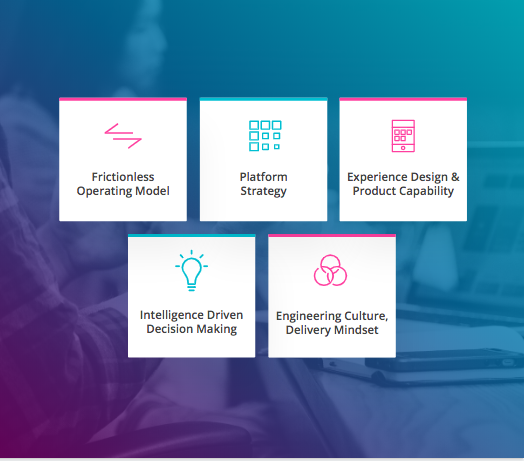
Making the data dream a reality
As a senior technology executive at a major bank, she said, she dreamed of data. And not just any data - “data that was structured and not siloed, centralized and not scattered to the four corners of our organization. Data that was available and accessible.”
The key to digital fluency
Just why is this on so many wish lists? For Gary O’Brien, Thoughtworks Digital Fluency Principal, the answer is simple. The “strategic use of information assets,” where data serves as the basis for informed decision-making, is an essential element to achieving digital fluency - the collection of capabilities that allow enterprises to thrive in a tech-saturated, rapidly evolving environment.
The Building Blocks of a Modern Digital Business
"Data has had such a significant impact on the way companies are functioning right now. We can now create value-added products with the use of data we have. New product, new opportunity, new insight and a far greater understanding of the customer."
Gary O'Brien, Digital Fluency Principal, Thoughtworks
Yet for a lot of organizations the data dream remains a distant one. Overall, the migration of business to digital channels mean firms collect and use more data than ever. But according to Thoughtworks principal consultant Zhamak Dehghani, most are still in “crisis” mode when it comes to using that data.
“The inconvenient truth is that companies are failing in their effort to become data-driven, to become AI-first and fundamentally compete based on analytics,” she said.
The main problem as Dehghani sees it is that the “standard” enterprise architecture is still based around a centralized, monolithic system that’s incapable of scale. Customer information from different functions is rarely connected or shared, preventing the construction of a 360-degree view.
Out with the old
What’s needed is a “mesh” of interlocking data sets based on standardization and interoperability, where various domains are “empowered to share analytical data in an easily consumable way,” she explained.
Companies can start down this road by identifying points of interaction between domains where new data products can be created, and applying analytics to automate decisions based on this data. This creates a cycle of “connected intelligence,” where data is constantly and seamlessly dictating the next phase of development or customer outreach. 
Industry leaders at the event agreed on the pressing need for new data approaches. Nigel Dalton, chief inventor at Australian real estate platform, REA Group, noted most businesses still draw an artificial line between their “digital” and “analog” operations, when data from each should be informing the other. “Collecting and connecting your data is vital to creating seamless online to offline customer experiences,” he said.
Frank Mollerop of survey provider, QuestBack, urged companies to move beyond parsing transactional data to focus on indicators of employee and customer experience, since “experiences are driving decisions today.”
“That data set is going to be the new gold mine for companies going forward,” Mollerop added.
Representatives of the Chicago-based Invisible Institute, and the City of New Orleans Independent Police Monitor, which have collaborated on a project that uses data to shed light on problematic law enforcement trends, provided a valuable reminder that in the rush to leverage data resources companies need to remain conscious of trust - and, as Invisible Institute founder Jamie Kalven put it, that behind every data point there’s a human story. With findings from the project now helping improve police-community relations in New Orleans, the discussion also testified to data’s ability to drive powerful results.
“Having the information, curating it well, analyzing it well, looking for patterns beyond the individual case allows for a kind of joint problem-solving approach to reform,” Kalven said. “It allows for the lived experiences of people to be more visible.”
Disclaimer: The statements and opinions expressed in this article are those of the author(s) and do not necessarily reflect the positions of Thoughtworks.

















